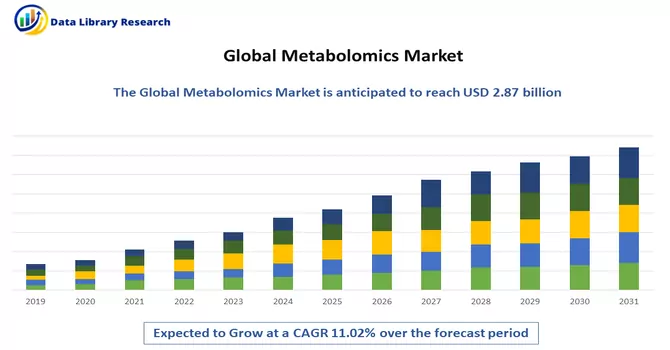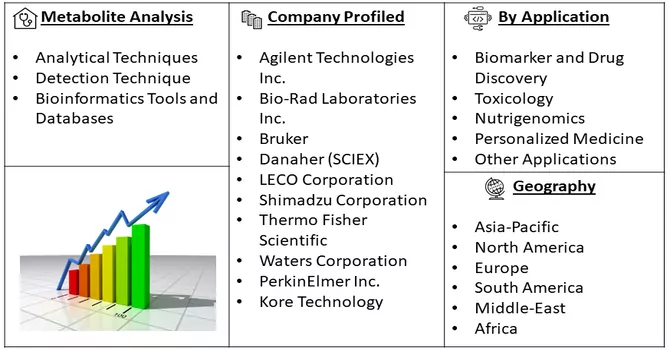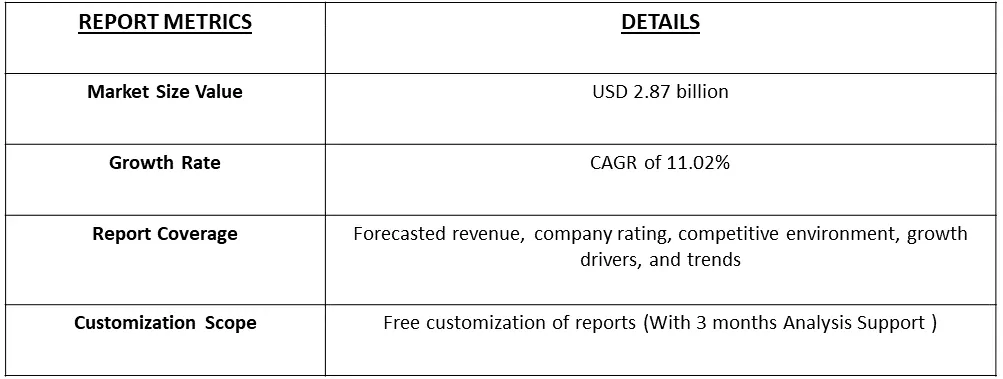The Global Metabolomics Market is estimated at USD 2.87 billion in 2023 and is expected to register a CAGR of 11.02% during the forecast period (2024-2031).

Get Complete Analysis Of The Report - Download Free Sample PDF
Metabolomics is a field of study in biology that involves the comprehensive analysis of small molecules, known as metabolites, within a biological system. These metabolites are the end products of various cellular processes, such as metabolism. Metabolomics aims to identify and quantify the diverse array of metabolites present in biological samples, such as cells, tissues, or biofluids, to gain insights into the metabolic pathways and physiological processes occurring in the organism. The analytical techniques used in metabolomics often involve advanced technologies like mass spectrometry and nuclear magnetic resonance (NMR) spectroscopy. By analyzing the metabolome, which represents the complete set of metabolites in a biological system, researchers can better understand the biochemical changes associated with various physiological and pathological conditions. Metabolomics has applications in fields such as medicine, environmental science, and agriculture, contributing to a more comprehensive understanding of complex biological systems.
The metabolomics market is witnessing robust growth driven by several key factors. Technological advancements in analytical instruments, particularly mass spectrometry and nuclear magnetic resonance, have substantially improved the precision and efficiency of metabolite analysis. The escalating demand for personalized medicine and the identification of biomarkers in various medical domains, such as oncology and metabolic disorders, is fueling research and investments in metabolomics. Collaborations between academic institutions and industry entities are fostering innovation and the establishment of standardized protocols, as demonstrated by initiatives like the Center of Excellence in Clinical Metabolomics. The expanding applications of metabolomics across pharmaceuticals, biotechnology, and environmental sciences are further propelling market expansion, recognizing its potential for offering comprehensive insights into biological systems and disease mechanisms. Additionally, the growing recognition of the significance of understanding metabolic pathways in health and disease is expected to sustain the upward trajectory of the metabolomics market.
Market Segmentation: The Global Metabolomics Market is Segmented by Metabolite Analysis (Analytical Techniques, Detection Techniques, and Bioinformatics Tools and Databases), Application (Biomarker and Drug Discovery, Toxicology, Nutrigenomics, Personalized Medicine, and Other Applications), and Geography (North America, Europe, Asia-Pacific, Middle-East and Africa, and South America). The report offers the market sizes and forecasts in terms of value (USD million) for the above segments.

For Detailed Market Segmentation - Download Free Sample PDF
In the metabolomics market, several notable trends are shaping the industry landscape. The increasing adoption of artificial intelligence (AI) and machine learning (ML) in data analysis is enhancing the interpretation and extraction of meaningful insights from complex metabolomic datasets, thereby improving the efficiency and accuracy of results. Moreover, there is a growing focus on developing user-friendly software solutions that facilitate data processing and interpretation for researchers with varying levels of expertise. The rise of multi-omics approaches, integrating metabolomics with genomics, proteomics, and other -omics disciplines, is enabling a more comprehensive understanding of biological systems and contributing to advancements in precision medicine. Furthermore, the emergence of targeted and non-targeted metabolomics methods is offering researchers flexibility in their analytical approaches, catering to specific research objectives. As the metabolomics field expands its applications beyond traditional research areas into clinical diagnostics, nutrigenomics, and environmental monitoring, the market is witnessing a diversification of end-users and increased collaborations between academia and industry, further driving innovation and market growth.
Market Drivers:
Rising Demand for Personalized Medicines
The rising demand for personalized medicines has significantly influenced the utilization of metabolomics in healthcare. Metabolomics, with its ability to provide comprehensive insights into an individual's metabolic profile, is playing a pivotal role in tailoring therapeutic interventions to specific patient needs. This approach allows for a more precise understanding of variations in drug responses, optimizing treatment efficacy while minimizing adverse effects. Metabolomic profiling enables the identification of unique biomarkers associated with diseases, facilitating early diagnosis and targeted therapies. As the healthcare industry increasingly shifts towards personalized and precision medicine, metabolomics has emerged as a valuable tool in stratifying patient populations, predicting treatment outcomes, and advancing the development of targeted therapies. The integration of metabolomics data into clinical decision-making processes is anticipated to enhance treatment strategies, ultimately contributing to more effective and individualized patient care.
High Investments by Public and Private Sectors in Metabolomics
The field of metabolomics has witnessed a surge in investments from both the public and private sectors, underscoring the growing recognition of its potential and importance in various scientific and healthcare applications. Public institutions, governmental bodies, and research organizations are allocating substantial funds to support metabolomics research initiatives, aiming to deepen our understanding of metabolic pathways, disease mechanisms, and potential therapeutic targets. Concurrently, private sector entities, including biotechnology and pharmaceutical companies, are actively investing in metabolomics technologies to enhance drug discovery and development processes. This heightened interest is fueled by the capability of metabolomics to provide detailed insights into the metabolic signatures associated with diseases, facilitating biomarker discovery and personalized medicine approaches. The collaborative efforts between public and private sectors in funding metabolomics research not only accelerate scientific advancements but also contribute to the translation of metabolomics discoveries into practical applications, fostering innovation and the development of novel diagnostic tools and therapies. The substantial investments reflect the collective commitment to harnessing the full potential of metabolomics for improving healthcare outcomes and addressing complex biological challenges.
Market Restraints:
High Cost of Tools and Instruments
The notable growth of the metabolomics market is encountering a potential impediment in the form of the high cost associated with the requisite tools and instruments. The sophisticated technologies, such as mass spectrometry and nuclear magnetic resonance spectroscopy, essential for conducting metabolomics research, often come with a substantial financial burden. This elevated cost of entry can act as a deterrent for smaller research institutions, laboratories, and academic facilities, hindering their ability to adopt and leverage metabolomics methodologies. Additionally, the financial investment required for maintaining and upgrading these advanced instruments poses an ongoing challenge. The high operational costs may limit the accessibility of metabolomics techniques, impeding widespread adoption and collaboration across diverse scientific domains. Addressing this cost barrier is crucial for ensuring broader inclusivity and facilitating the integration of metabolomics into various research and clinical applications, thereby unlocking the full potential of this field for advancements in personalized medicine, biomarker discovery, and disease understanding. Efforts to optimize instrument costs and explore cost-effective alternatives may play a pivotal role in overcoming this challenge and sustaining the continued growth of the metabolomics market.
The COVID-19 pandemic had a detrimental effect on the metabolomics market due to constrained access to essential laboratory reagents, testing kits, and analytical tools. Despite these challenges, there was an evident surge in public awareness regarding the significance of metabolomics amid the pandemic. This heightened awareness prompted researchers to actively explore additional applications of metabolomics in combating COVID-19 infections. The global crisis served as a catalyst for increased experimentation and innovation within the metabolomics field as scientists sought to contribute to the understanding and management of the pandemic's impact. While the initial impact was adverse, the pandemic has underscored the importance of metabolomics, stimulating a renewed focus on its potential applications beyond the immediate challenges posed by COVID-19.
Segmental analysis:
Nuclear Magnetic Resonance Spectroscopy Segment is Expected to Witness Significant Growth Over the Forecast Period
Nuclear Magnetic Resonance Spectroscopy (NMR) stands as a cornerstone in metabolomics, playing a pivotal role in elucidating the intricate world of metabolites within biological systems. This analytical technique harnesses the magnetic properties of atomic nuclei to offer a non-destructive and highly reproducible method for characterizing a diverse array of metabolites in biological samples. NMR's strengths lie in its capacity for simultaneous detection and quantification of multiple metabolites, enabling comprehensive analyses of metabolic profiles and alterations associated with various physiological or pathological conditions. Its ability to provide information on metabolite connectivity and interactions contributes to unravelling complex metabolic networks. Despite challenges like lower sensitivity compared to mass spectrometry, ongoing technological advancements in NMR continue to enhance its capabilities, solidifying its indispensable role in facilitating holistic metabolomic analyses and advancing our understanding of cellular processes and metabolic pathways.
Biomarker and Drug Discovery Segment is Expected to Witness Significant Growth Over the Forecast Period
Metabolomics plays a crucial role in biomarker discovery and drug development, offering valuable insights into the identification and characterization of biomolecules indicative of various physiological and pathological states. In the realm of biomarker discovery, metabolomics enables the identification of specific metabolic signatures associated with diseases, aiding in the early diagnosis, prognosis, and monitoring of conditions such as cancer, metabolic disorders, and cardiovascular diseases. These unique metabolic profiles serve as potential biomarkers that can be detected in bodily fluids, providing a non-invasive approach for disease detection and personalized medicine. In drug discovery, metabolomics contributes to understanding the biochemical changes induced by drug candidates within biological systems. By analyzing the metabolic response to drug interventions, researchers can uncover potential drug targets, evaluate drug efficacy, and assess potential side effects. Metabolomics also facilitates the optimization of drug formulations and dosages, enhancing the efficiency and safety of pharmaceutical interventions. The integration of metabolomics with other omics technologies, such as genomics, proteomics, and transcriptomics, further strengthens the drug discovery process, providing a comprehensive view of the molecular mechanisms underlying diseases and drug responses. As pharmaceutical companies increasingly recognize the importance of personalized medicine, metabolomics emerges as a powerful tool for tailoring drug therapies to individual patient characteristics, thereby improving treatment outcomes and minimizing adverse effects. Overall, the application of metabolomics in biomarker discovery and drug development is instrumental in advancing precision medicine and shaping the future of healthcare.
North America Region is Expected to Witness Significant Growth Over the Forecast Period
North America stands as a prominent hub for metabolomics research and applications, playing a pivotal role in advancing this field of study. The region is home to a significant number of leading metabolomics research institutions, pharmaceutical companies, and biotechnology firms, fostering a robust environment for scientific innovation and collaboration. The widespread adoption of advanced analytical technologies, including mass spectrometry and nuclear magnetic resonance spectroscopy, has positioned North America at the forefront of metabolomics research, allowing for in-depth analyses of complex metabolic pathways and the identification of biomarkers associated with various diseases. Moreover, the North American metabolomics market is driven by a strong emphasis on precision medicine, with a focus on tailoring healthcare interventions to individual patient profiles. The integration of metabolomics data with other omics disciplines, such as genomics and proteomics, is facilitating a comprehensive understanding of biological systems and contributing to advancements in personalized therapies. The region's robust healthcare infrastructure and supportive regulatory environment further contribute to the growth of metabolomics applications in clinical research and diagnostics. Collaborations between academic institutions, private enterprises, and government agencies in North America continue to drive technological advancements and the development of standardized protocols in metabolomics. The region's commitment to fostering innovation, coupled with a high level of investment in research and development, solidifies North America's position as a key player in shaping the future landscape of metabolomics and its applications in healthcare and life sciences.

Get Complete Analysis Of The Report - Download Free Sample PDF
The landscape of the metabolomics market exhibits a moderate level of competitiveness with the presence of numerous major players. In this dynamic environment, pharmaceutical companies notably favour collaboration with research institutes for the characterization of toxicological studies and the exploration of novel drug development avenues, particularly in the context of combating infectious diseases. A noteworthy trend contributing to the market's evolution is the swift global adoption of technical advancements, with a notable emphasis on combining metabolomics methodologies with Mass Spectrometry (MS) and Nuclear Magnetic Resonance (NMR). This strategic integration of technologies aims to enhance the precision and scope of metabolite analysis, reflecting the industry's commitment to staying at the forefront of innovation. As these trends continue to shape the metabolomics landscape, collaborations between pharmaceutical entities and research institutions are likely to play a pivotal role in advancing scientific understanding and facilitating the development of innovative therapeutic solutions. Some of the key market players working in this segment are:
Recent Development:
1) In July 2021, a collaborative effort between Thermo Fisher Scientific Inc. and the University of California, Davis resulted in the establishment of the Center of Excellence in Clinical Metabolomics. This research partnership aims to deliver cutting-edge innovations, share best practices, and develop standard operating procedures to benefit the metabolomics community.
2) In April 2021, BioMérieux SA achieved CE Marking for the VITEK MS PRIME, an innovative MALDI-TOF mass spectrometry identification system. This milestone marks a crucial advancement in the field of microbiology, streamlining the process of rapidly identifying microorganisms, a pivotal step in microbiological workflows.
Q1. What was the Metabolomics Market size in 2023?
As per Data Library Research the Global Metabolomics Market is estimated at USD 2.87 billion in 2023.
Q2. At what CAGR is the Metabolomics market projected to grow within the forecast period?
Metabolomics Market is expected to register a CAGR of 11.02% during the forecast period.
Q3. What are the Growth Drivers of the Metabolomics Market?
Rising Demand for Personalized Medicines and High Investments by Public and Private Sectors in Metabolomics are the Growth Drivers of the Metabolomics Market.
Q4. Which region has the largest share of the Metabolomics Market? What are the largest region's market size and growth rate?
North America has the largest share of the market. For detailed insights on the largest region's market size and growth rate request a sample here.
Data Library Research are conducted by industry experts who offer insight on industry structure, market segmentations technology assessment and competitive landscape (CL), and penetration, as well as on emerging trends. Their analysis is based on primary interviews (~ 80%) and secondary research (~ 20%) as well as years of professional expertise in their respective industries. Adding to this, by analysing historical trends and current market positions, our analysts predict where the market will be headed for the next five years. Furthermore, the varying trends of segment & categories geographically presented are also studied and the estimated based on the primary & secondary research.
In this particular report from the supply side Data Library Research has conducted primary surveys (interviews) with the key level executives (VP, CEO’s, Marketing Director, Business Development Manager and SOFT) of the companies that active & prominent as well as the midsized organization
FIGURE 1: DLR RESEARH PROCESS

Extensive primary research was conducted to gain a deeper insight of the market and industry performance. The analysis is based on both primary and secondary research as well as years of professional expertise in the respective industries.
In addition to analysing current and historical trends, our analysts predict where the market is headed over the next five years.
It varies by segment for these categories geographically presented in the list of market tables. Speaking about this particular report we have conducted primary surveys (interviews) with the key level executives (VP, CEO’s, Marketing Director, Business Development Manager and many more) of the major players active in the market.
Secondary ResearchSecondary research was mainly used to collect and identify information useful for the extensive, technical, market-oriented, and Friend’s study of the Global Extra Neutral Alcohol. It was also used to obtain key information about major players, market classification and segmentation according to the industry trends, geographical markets, and developments related to the market and technology perspectives. For this study, analysts have gathered information from various credible sources, such as annual reports, sec filings, journals, white papers, SOFT presentations, and company web sites.
Market Size EstimationBoth, top-down and bottom-up approaches were used to estimate and validate the size of the Global market and to estimate the size of various other dependent submarkets in the overall Extra Neutral Alcohol. The key players in the market were identified through secondary research and their market contributions in the respective geographies were determined through primary and secondary research.
Forecast Model
